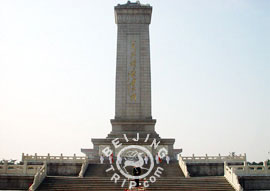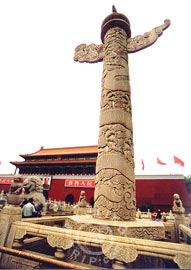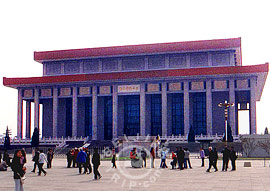Tian'anmen(天安门)-the Gate of China, Beijing
With a total area of 440,000 square meters, Tiananmen Square is the largest square in the center of Beijing. For over a hundred years, many ceremony and demonstrations have been held here. The grandeur of Tiananmen Gate (Heavenly Peace Gate) is a national symbol, with the Great Hall of the People on the western side and the Museum of the Chinese Revolution and the Museum of Chinese History to its east and west. The Monument to the People's Heroes - the 36 meters obelisk, made of Qingdao granite, dominates the center of the square. The Chairman Mao Memorial Hall and the Qianmen gate, sit in the south.
Tian'anmen Gate
 Tian'anmen Gate (Gate of Heavenly Peace) was built in the 15th Century and restored in the 17th Century. From imperial days, the yellow glaze-tiled double-eaves tower functioned as a rostrum for proclamations to the assembled masses. October 1, 1949, Chairman Mao Zedong proclaimed the founding of the new China. The tower has five doors and in front of it are seven bridges spanning a stream. Only the emperor could use the central door and bridge. On the top of the central door is a gigantic portrait of Chairman Mao with slogans on each side stating 'Long Live the People's Republic of China' and 'Long Live the Unity of the Peoples of the World'. Walking through the gate, you can enter the imperial city - Forbidden City with free charge while a panoramic view from the tower costs 15RMB for Foreigners.
Tian'anmen Gate (Gate of Heavenly Peace) was built in the 15th Century and restored in the 17th Century. From imperial days, the yellow glaze-tiled double-eaves tower functioned as a rostrum for proclamations to the assembled masses. October 1, 1949, Chairman Mao Zedong proclaimed the founding of the new China. The tower has five doors and in front of it are seven bridges spanning a stream. Only the emperor could use the central door and bridge. On the top of the central door is a gigantic portrait of Chairman Mao with slogans on each side stating 'Long Live the People's Republic of China' and 'Long Live the Unity of the Peoples of the World'. Walking through the gate, you can enter the imperial city - Forbidden City with free charge while a panoramic view from the tower costs 15RMB for Foreigners.
 Huabiao
Huabiao
Right beside a pair of marble lions in front of the Tian'anmen Gate stand obelisk of marble engraved with entwisting dragons and clouds - an ornamental architecture called Huabiao. Its history can be traced back to the Yao and Shun, legendary kings in remote antiquity. To solicit public criticism, it is said that wooden crosses were erected at marketplaces for people to write down complaints. Later during the Han (206 B.C. -- 220 A.D.) wooden posts were replaced by stone pillars, which gradually became the sumptuous columns to palace gates. Huabiao can be usually found in imperial gardens and mausoleums.
On the top is a plate-shape flat called Chenglupan (dew-collecting) on which squats an animal called kong (a legendary animal for watch-keeping) facing to the south. They were called "Wangjungui" or "looking forward to the emperor's return," who watched over the emperor's excursions and called him back. The couple inside the gate facing north, called Wangjunchu or "looking forward to the emperor's progress," were considered to supervise the emperor's behavior in the court when he neglect court affairs.
Great Hall of the People
 This is the venue of the legislature, the National People's Congress. Summit meetings are often held in the 10,000-seat auditorium with the familiar red star embedded in a galaxy of lights in the ceiling. Also you can visit the 5000 seat banquet room where US president Richard Nixon dined in 1972. The admission costs £¤ 15.
This is the venue of the legislature, the National People's Congress. Summit meetings are often held in the 10,000-seat auditorium with the familiar red star embedded in a galaxy of lights in the ceiling. Also you can visit the 5000 seat banquet room where US president Richard Nixon dined in 1972. The admission costs £¤ 15.
Monument to the People's Heroes (Renmin Yingxiong Jinianbei)
Built in 1958 on the southern side of Tian'anmen Square, this 36-meter obelisk bears brass-relief carvings of key revolutionary events such as the Chinese destroying opium in the 19th century.
Mao Zedong Memorial Hall (Mao Zhuxi Jiniantang)
Behind the Monument to the People's Heroes is the hall where the embalmed body of Chairman Mao is kept and many Chinese show deep respect when confronted with the physical presence of Mao. more
Opening: 9:00 - 16:30
Google Maps,Google Maps coordinate,Only show at Item-Page.
位于北京城的中轴线上的天安门,始建于明永乐十五年(14l7年)。原名承天门,以示皇帝“承天启运,受命于天”。清顺治八年(1651年)重建后,改称天安门.既包含了皇帝是替天行使权力。理应万世至尊的意旨;又寓有“外安内和,长治久安”的含义。明、清时,天安门是皇城的正门,城门五阙,重楼九楹,高为33.87米;1970年翻建后高达34. 7米。它造型典雅,是我国传统建筑艺术的代表作。
天安门的主体建筑分为上下两层。上层是重檐歇山式,黄琉璃瓦顶的巍峨城楼,东西面阔九楹,南北进深五间,取“九五”之数,象征皇帝的尊严。正面有36扇菱花格式的门窗。城搂基座周围有汉白玉栏杆、栏板,雕刻着莲花宝瓶图案。城楼内所用木材大部分是楠木,60根红漆巨柱排列整齐,柱顶上有藻井与梁枋,绘着金龙吉祥彩画和团龙图案。地面铺的全是金砖,面积约2000平方米。屋顶的正脊与垂脊上装饰着螭吻、仙人、走兽。下层是高13米的朱红色城台,四周环绕琉璃瓦封顶的矮墙,下部是1.59米高的雕刻精美的汉白玉须弥座台基。城台的总面积达4800平方米,东西两侧各有一条长达百级供上下城楼用的梯道,俗称马道。还有5个拱形门洞,中间的门洞最大,高8.82米,宽5.25米,唯有皇帝可以进出。城楼前有外金水河,河上飞架7座汉白玉雕栏石桥,中间一座最宽阔的称“御路桥”。专为皇帝而设;御路桥两旁有宗室亲王过往的“王公桥”;王公桥左右的“品级桥”是供三品以上的官员行走的;四品以下的官员和兵弁、夫役只能走“公生桥”。公生桥架在太庙(劳动人民文化宫)和社稷坛(中山公园)门前。5座内金水桥除有类似严格的等级规定外,还表示“万方来朝”之意。金水河两岸有两对威风凛凛的石狮及两座连同须弥座高为9.57米的华表。石狮系明代永乐年间原物,距今已有500多年。石狮后面两边设有红色观礼台,台前东西各筑花坛,游人们常在这里驻足观景。华表上满刻着盘龙与云朵,巨柱顶端加上了云板、承露盘并蹲坐着石兽,此兽有注视皇帝出入之意,因而人们把前华表上两只背北面南的石兽叫“望君归”;把后华表上两只背南面北的石兽称“望君出”。
天安门在明、清两朝是皇帝颁发诏令之地。遇有新皇帝登基、大婚等重大庆典活动和皇帝父母进宫,都要启用天安门。皇帝平时一般不走天安门。只有每年去祭天、祭地、祭五谷时,才由此门出入。另外,皇帝御驾亲征或大将出征,都得在天安门前祭路、祭旗,以求马到成功,凯旋归来,同时显示威风。天安门还是“金殿传胪”的场所。每逢殿试后的两天,皇帝召见、传呼新中进士们的姓名,这叫“传胪”。考中前三名的状元、榜眼、探花插上金花,身披红绸,骑马游街,以谢皇恩。天安门唯独皇帝可以出入,而且只能出入喜事,绝对禁止出入丧事。
天安门是中华人民共和国举行开国大典的主会场,也是国徽图案的重要组成部分。它是我们伟大祖国的象征,已成为人们喜爱的观瞻胜地。more













No comments:
Post a Comment